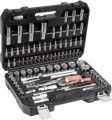Socket heads (6 points)
Number of
hex sockets included in the tool kit.
All end heads are accessories for a collapsible tool; during operation, they are mounted on a ratchet, wrench or other similar device. The head itself has the appearance of a characteristic “cap”, which, during operation, is put on a bolt, nut, etc. This design, among other things, allows you to work with parts located in recesses and some other hard-to-reach places that cannot be reached with open-ended, captive or split keys. And compared to a set of classic socket wrenches, the holder plus socket set takes up much less space, providing almost the same functionality.
As for the 6 faces, this type of socket head is the most famous and widespread, because. most modern nuts and bolts have this shape.
Socket heads sizes (6 points)
Working size range of hex sockets (see above) supplied with the kit. This parameter allows you to evaluate how the heads fit the dimensions of the fasteners with which they are planned to be used.
Socket heads (12 points)
Number of
dodecahedral sockets included in the tool kit.
All end heads are accessories for a collapsible tool; during operation, they are mounted on a ratchet, wrench or other similar device. The head itself has the appearance of a characteristic “cap”, which, during operation, is put on a bolt, nut, etc. This design, among other things, allows you to work with parts located in recesses and some other hard-to-reach places that cannot be reached with open-ended, captive or split keys. And compared to a set of classic socket wrenches, the holder plus socket set takes up much less space, providing almost the same functionality.
Specifically, the 12-sided type of socket heads is considered more versatile than the hexagonal one: it makes it possible to work with both classic hexagonal fasteners and, in fact, twelve-sided ones. In addition, to hook the next face, it is enough to rotate such a tool by only 30 ° when rearranging (whereas for 6-sided nozzles this figure is 60 °, and in cramped conditions there may not be room for this). On the other hand, 12-sided parts are quite rare, and when working with hexagonal parts, the contact area is small, which increases the risk of stripping edges and reduces torque.
Socket heads sizes (12 faces)
Working size range of dodecahedral sockets (see above) supplied with the kit. This parameter allows you to evaluate how the heads fit the dimensions of the fasteners with which they are planned to be used.
Adapter
An adapter for docking seemingly incompatible elements from a set. For example, socket heads with an unsuitable landing square on a ratchet, screwdriver handle or in a drill driver.
The adapter provides full-fledged work with all the required list of tools from the set.
Also in kit
Additional items included with the toolbox but not listed above. Here are some of those items:
— Adapter. Adapter from one type of mount to another. Quite often, adapters are designed to fit magnetic bits (see above) with a hex shank into a tool that uses a landing square, but there may be other options — for example, adapters between different sizes of the mentioned squares (see above).
— Holder for bits. A specific type of adapter designed to mount bits with a conventional hex shank in screwdrivers where a shank with a notch for a retainer is required. In extreme cases, they can also be used as improvised screwdrivers. Several holders can be supplied, in such cases they usually differ in length.
— Level. A tool for assessing the position of a particular surface. The simplest levels are for testing whether a surface is horizontal or not; however, tool kits usually include more advanced fixtures that allow you to also control verticality, and in some cases also check compliance with a 45 ° tilt and even measure a specific angle of deviation from the horizontal / vertical.
— Depth limiters. They are used together with drills (see above). They allow you to set the maximum drilling depth — the tool simply will not go further; this is useful in cases where you need to make holes of a given depth.
— Telescopic magnetic probe. A device in the form of an extendable rod (like an antenna or a pointer) with a strong permanent magnet at...the end. Facilitates the collection of small metal parts — for example, crumbled bolts or bits — including and in hard-to-reach places (like the space under the cabinet or a narrow gap between the boards).
— Lamp. Classic flashlight for lighting in dark places.
— Tester. He's an indicator. A specialized screwdriver for searching for a phase in electrical networks during electrical work. The indicator rod is almost completely covered with insulation, and a light bulb is located in the transparent handle. Such a device can also be used as a classic screwdriver, but it is not designed for applying great efforts — the main purpose is to search for the phase.
— Fastening devices — for example, screws with dowels. In normal cases, it is more convenient to buy fasteners separately, for specific needs; however, there are situations when the "emergency stock" provided in the kit is very handy.
This list is not exhaustive — manufacturers may provide other equipment, sometimes very specific.
Weight
The total weight of the tool kit. Indicated with a case, stand or other storage/transportation device (see Tool Storage). First of all, you should pay attention to this parameter if you plan to often carry the kit over long distances — the lighter the weight, the easier it will be to do. At the same time, extensive sets inevitably turn out to be weighty.

